by Emma H. Thomas
The Beginning
I began conducting my research on the taphonomy of animal bone at Cerro Mejía after being approached by my current faculty mentor, Dr. Donna Nash. Dr. Nash has worked on Cerro Mejía for many years and has recently become more interested in conducting experimental archaeological research to better understanding the Wari’s habits and cultural practices. Cooking and food processing is an essential element of a culture’s history; cultures cook meat (and as a result, certain bones) in ways which will have an effect on the physical nature of the bone.
Dr. Nash and I began the research project by seeking to answer three key research questions:
1. How are bones marked by the different manners of food processing or use?
2. How do these different processes affect the decay or preservation of animal bone in regards to color, texture, and other variables?
3. What social circumstances so these different processes imply?
Experimental Archaeology
The experimental aspect of the project was extensive, and required large amounts of camelid (in this case, alpaca) meat and bones. The better part of a month during the summer of 2011 was spent conducting the cooking experiments and laboratory analysis of Cerro Mejía’s archaeological faunal remains. The cooking experiments were meant to identify the distinct physical traits of each differently-heated type of bone, hopefully noticing trends in color, texture, et cetera that might lead us to identify physical similarities on the archaeological bone from Cerro Mejía. Noticing these connections could inform of our understanding of the Wari’s cooking and bone-burning practices and give the archaeological community a fuller awareness of pre-historic practices atop Cerro Mejía.
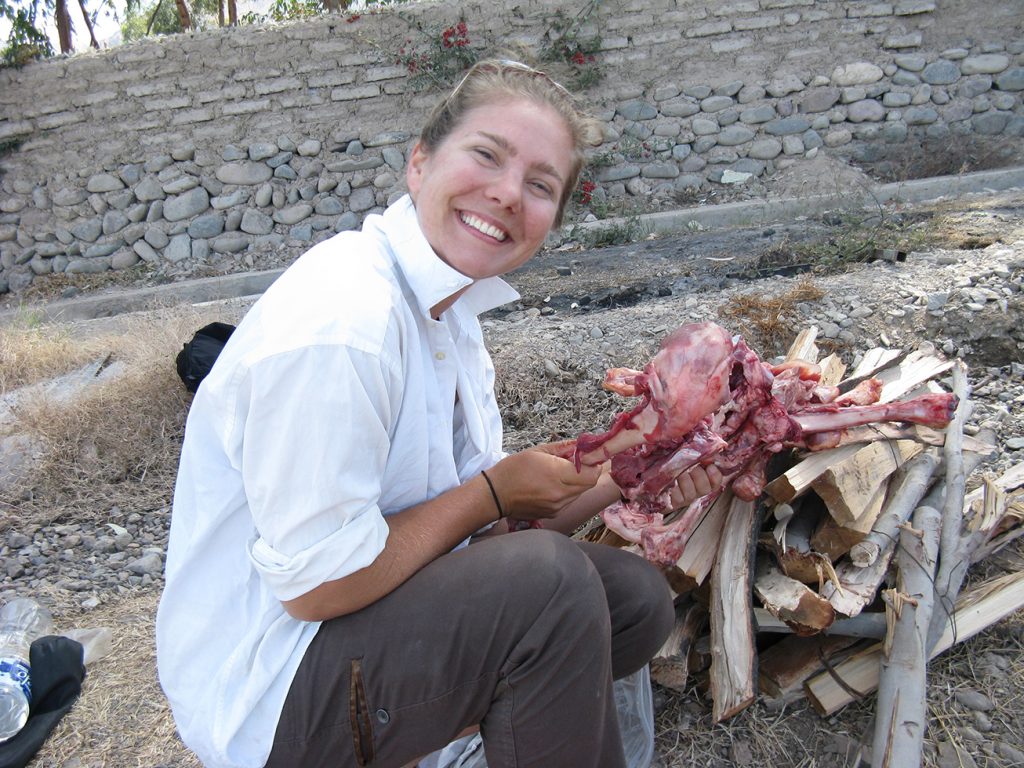
This photo was taken of me with some of the many kilos of alpaca meat and bone before conducting one of the project’s burning experiments.
Ethnozooarchaeology
We entered into the project by identifying two key informants to provide us with information about their cooking practices and recipe choices. Our original thoughts about which cooking experiments to conduct focused on boiling (for soup), rock-frying (in a manner conveyed to us by our informants), and burning (as if placed on a sacrificial fire during a Wari ritual). After speaking with our informants, we realized that there was another option with which we wanted to experiment, and also included baked bone (those baked in an earth oven). A set of bones was kept raw and a set (albeit an incomplete one) was included that was buried for a short period of time and then exposed to the sun and other elements for about two years. After identifying the different experiments that we wanted to conduct, the project was ready to begin.
The first necessary item was meat, and lots of it. We decided on a large sample size for each cooking method to increase our statistical power, and so four alpaca front limbs, four alpaca rear limbs, and one-half of an alpaca rib cage were purchased for each experiment. We also purchased wood and other implements needed for the various cooking styles, such as a large pot, adobe bricks, and vegetables and other spices.
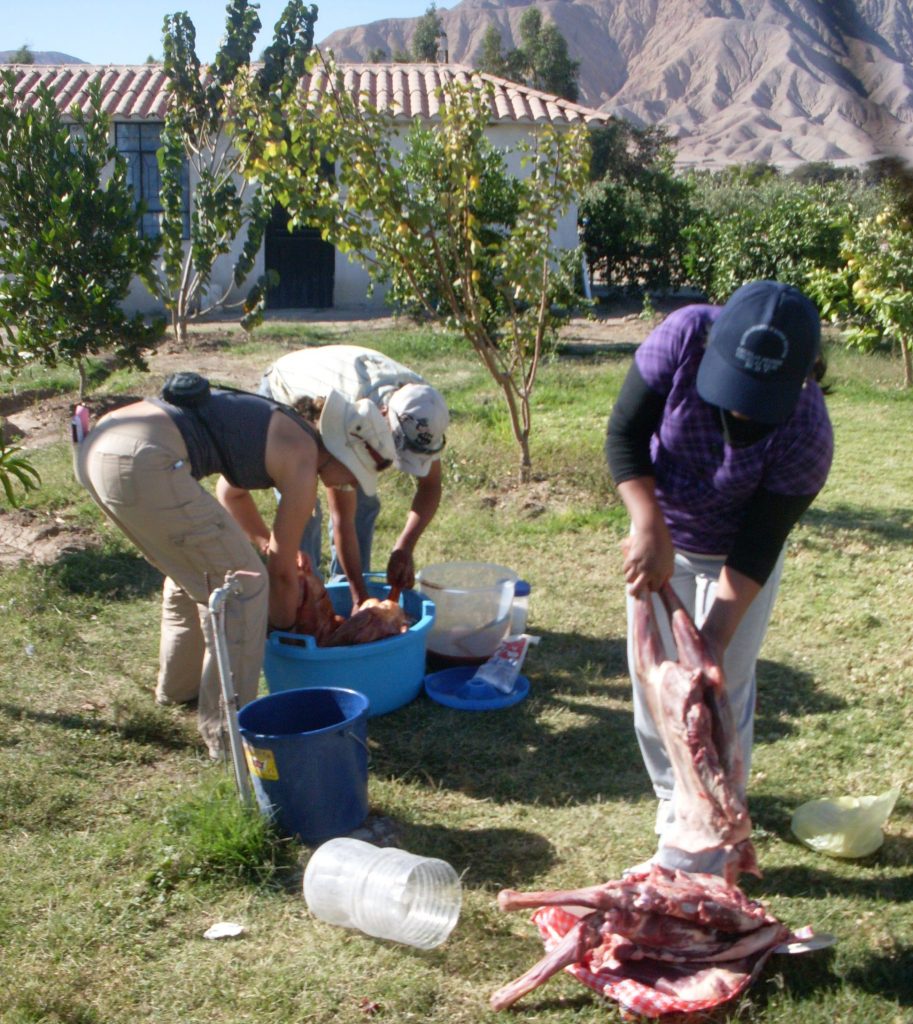
One of my informants sorts through the alpaca limbs while I help in marinading other alpaca limbs for our baking experiment.
Documentation Methods
Portions of all experiments were photographed, video-taped, and detailed notes were recorded for each. A high-grade thermometer was used to record the temperature of the various fires and all experiments were timed. Before, during, and after the cooking experiments, I interviewed my informants for greater detail about their approach to cooking these different dishes and their understanding about each step of the processes. Butchery methods, knowledge about the suitability of meat, the culinary use of different cuts, and all recipes were recorded for a complete ethnographic understanding of the practices of my Aymara informants. The Aymara are an indigenous group who still continue many traditions and life-ways similarly as in the past, and we hoped that by speaking with these women about their culinary practices we would have some insight into Wari practices.
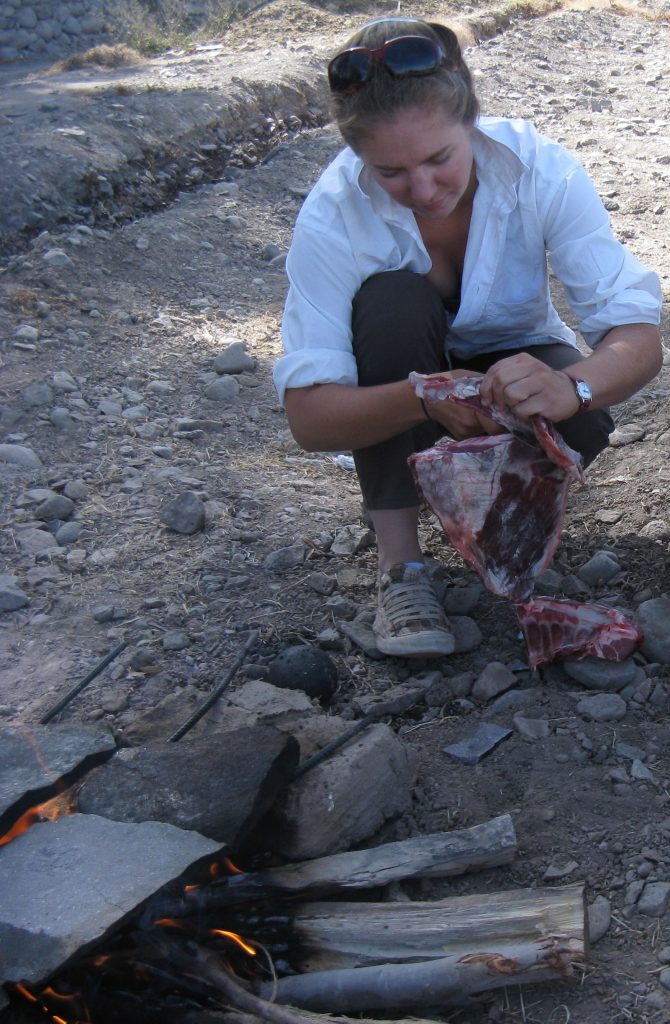 |
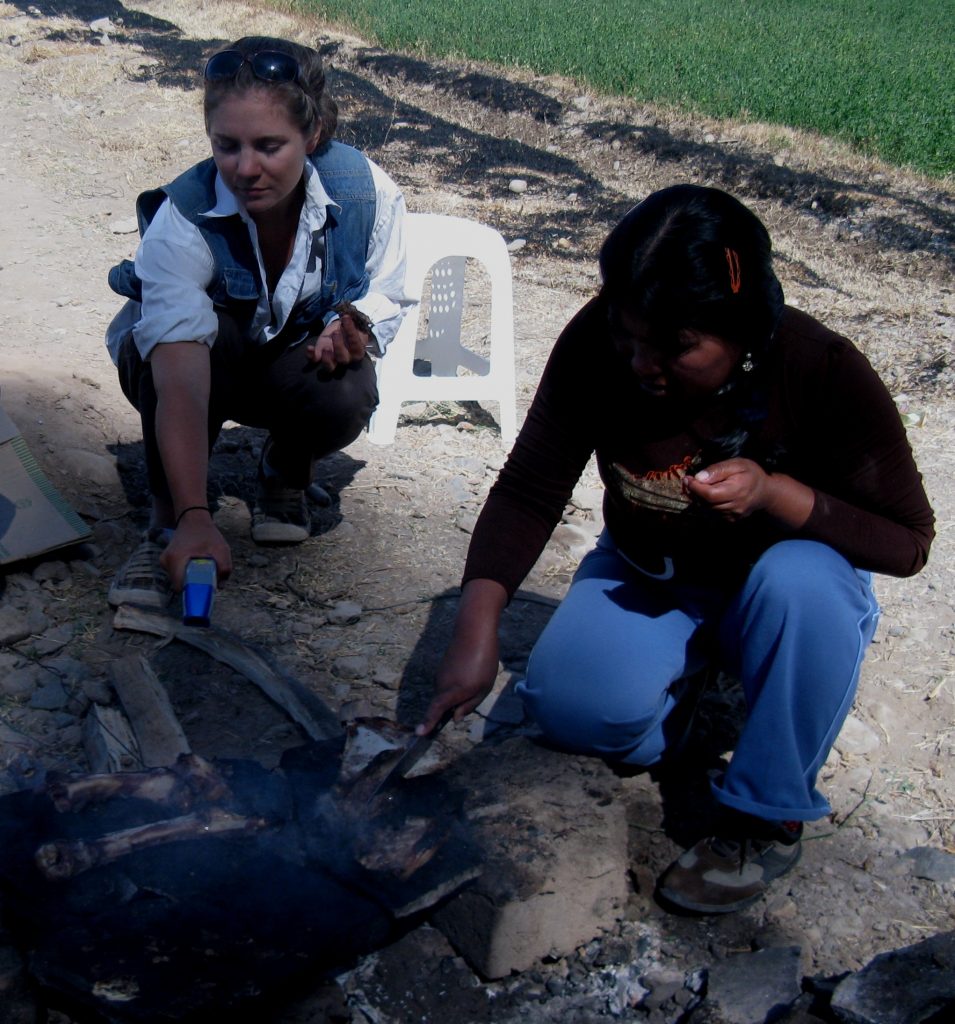 |
|---|
Left Image: I help cut meat into smaller pieces in preparation for rock-frying our dinner. Right Image: My informant cooks the alpaca while I take temperature measurements for the meat, the rock, and the fire itself.
Boiling and Soup Making
The first experiment that we began was the boiling experiment, and we decided that making a delicious soup that included our experimental specimens would be the most appealing option. Caldo blanco was our informants’ soup of choice, which included potatoes, chuño (an interesting Peruvian potato), mais pelado, and other delicious vegetables and spices. After we happily consumed the soup, the bones were saved and stored to be cleaned for analysis at a later date.
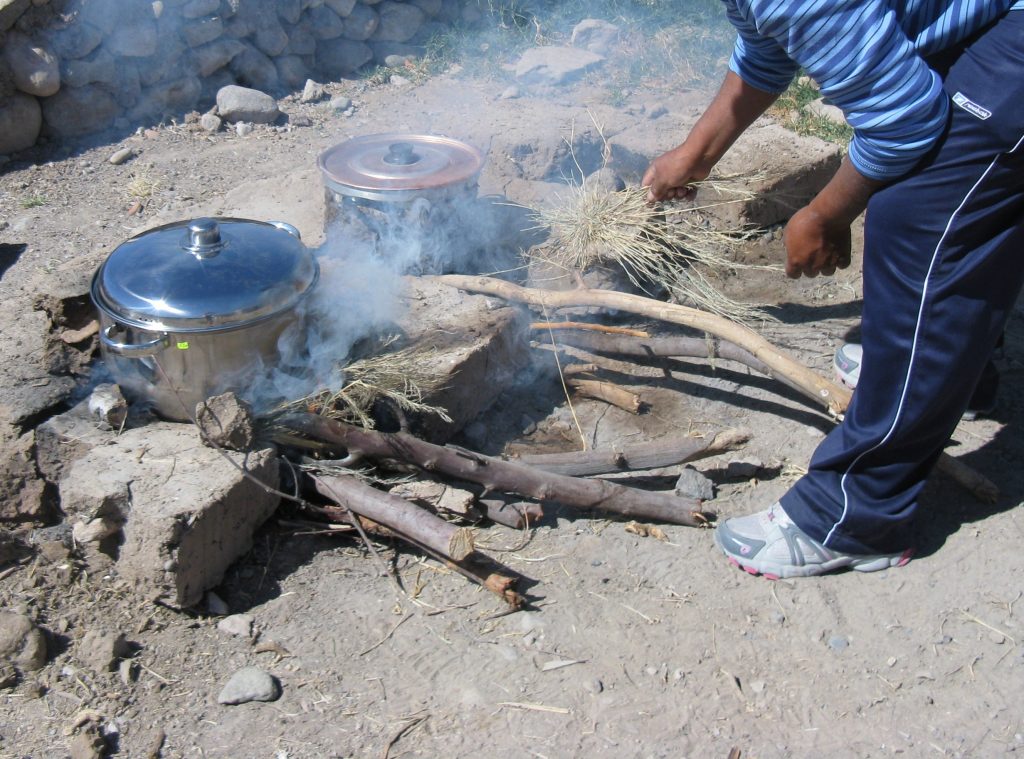 |
 |
|---|
Left Image: My informant feeds the fire with dried grasses to be sure that the water in the pot continues to boil. Right Image: The finished product of the boiling experiment, a delicious Caldo blanco soup!
Rock-Frying
The rock-fried meat was by far my favorite, and my informants propped a stone up over a fire to cook the meat for all hungry bystanders. Only salt was added to this alpaca meat—and salt is all that was needed. The fat and juices from the sizzling meat were appealing to all persons witnessing the experiment and all exclaimed “¡que rico!” (“how delicious/rich!”) after eating their warm meal.

A closer look at the rock-fried meat; while some meat is fully cooked and nearly ready to be removed and eaten, other cuts and bones have just been placed on the steaming hot rocks.
Baking in a Pacha Manka
The experiment in which we baked bones was the most complex and took the most planning, simply because we needed to build a Pacha Manka, an earth oven, in order to cook the meat. Adobe bricks and barro (mud) were used to create the oven and a hot fire was lit inside of the structure and allowed to burn down to embers. The Pacha Manka was then filled with hot rocks, marinated alpaca meat, sweet potatoes, corn, oca (a sweet and delicious tuber), as well as other foods, and was sealed on top with a tarp and more barro to make sure that the internal heat would bake all of the meat properly like an over-sized pressure-cooker. Unveiling the contents of the earth oven was a celebratory event and everyone clamored to look inside.
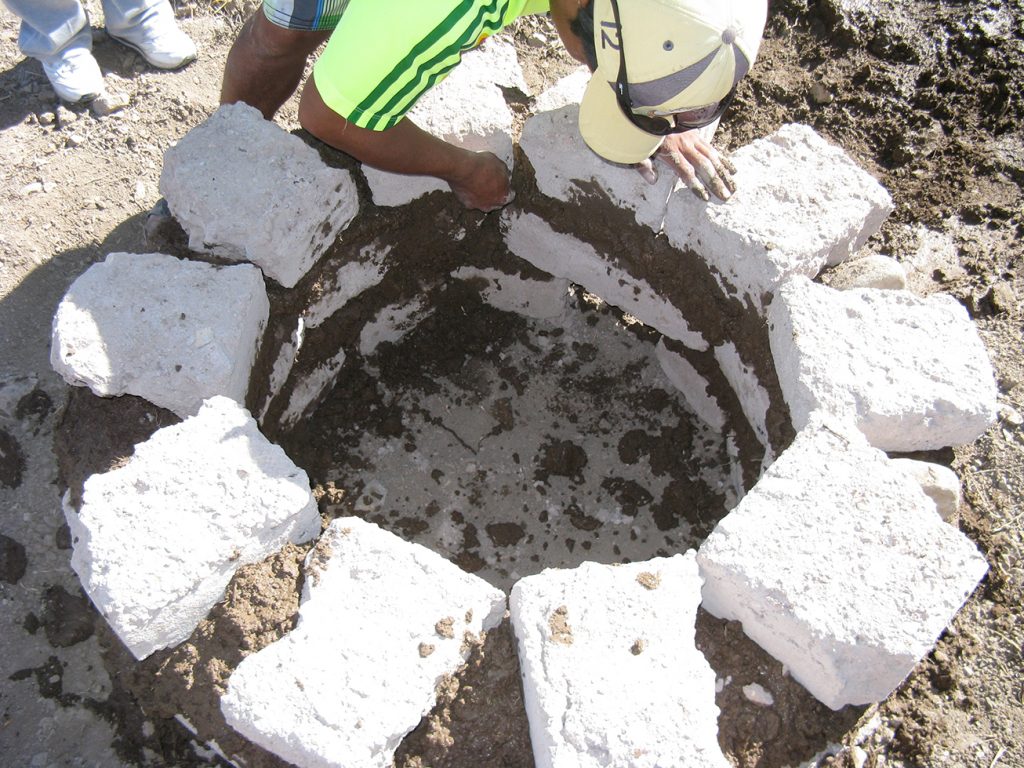 |
 |
|---|
Left Image: An informant builds the Pacha Manka with adobe bricks and barro. Right Image: The roaring fire that we’ve built inside the earth oven heats the rocks on top—these rocks will later be placed inside with the embers and food to facilitate the baking process.
Recreating a Sacrifical Fire
Bones were also burned in an extremely hot fire which was fueled by a large amount of firewood. Once the fire was roaring, we threw alpaca limbs onto the flames and then let the fire die down, attempting to imitate the circumstances that could have surrounded the burning of an animal which had been sacrificed during a Wari ritual occasion. The bones were left to cool overnight (after I discovered that they would melt themselves through a plastic bag even hours after the flames died down) and collected the next day.

The “sacrificially” fired alpaca limbs and rib cage crackle and pop as the fat and meat are burned off of the quickly blackening bones.
The Raw and the Sun-Roasted
A set of bones was also collected near Cerro Mejía which was from an experiment from previous years. These bones had been buried for a short time and then gradually became exposed to the elements, an process which greatly affected the appearance of the bones. As I mentioned before, a set of raw bones was procured so that we would have a control for the experiment. These two types of bones (sun-exposed and raw) were included in the analysis, along with the specimens from the four other cooking and burning experiments. It was our hope that the data collected from these six differently altered bone types would provide us with a solid foundation for comparison after I analyzed the archaeological bone from Cerro Mejía in the lab.
Analysis Time!
After all of the cooking experiments were finished, I further worked with my informants in cleaning the experimental bones for analysis and then began conducting the laboratory work with the Cerro Mejía specimens. On my last day in Perú, I finished the laboratory analysis and packed up the experimental specimens for storage. With my many, many data sheets in tow, I boarded the plane back to the United States.
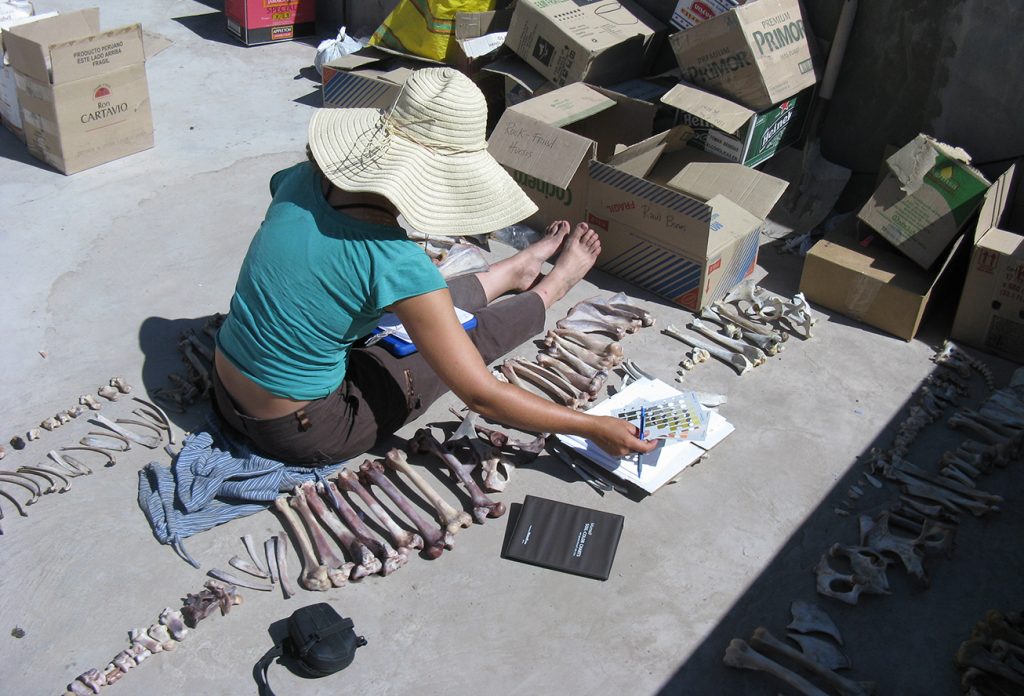 |
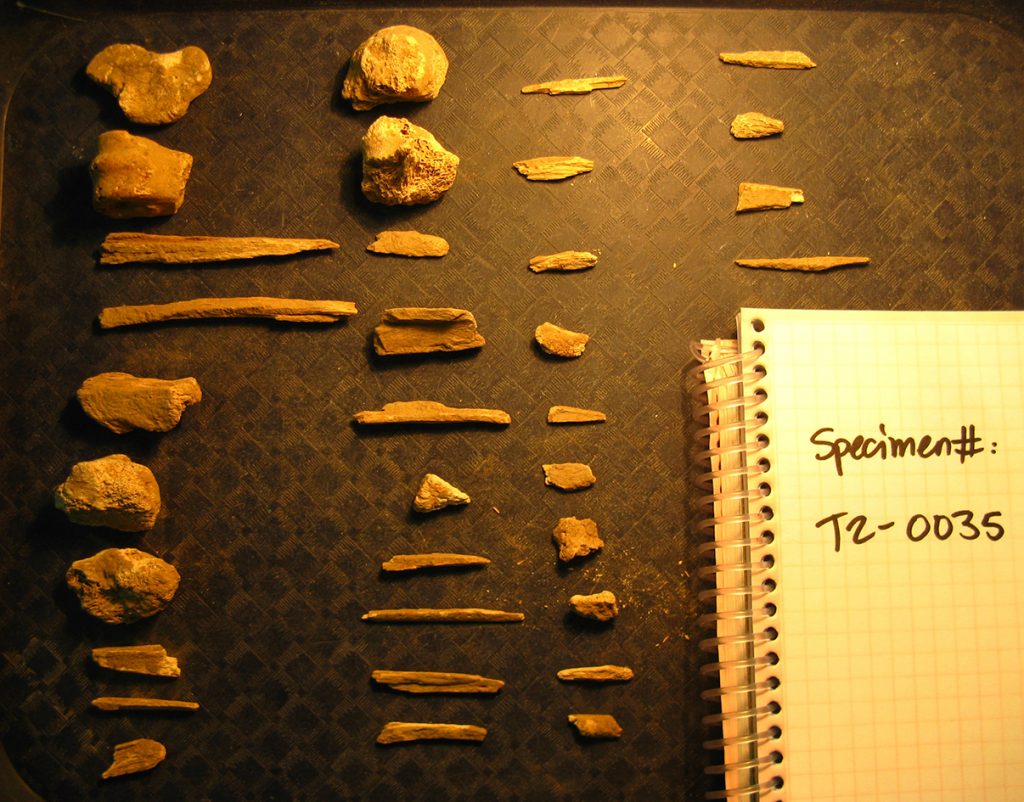 |
|---|
Left Image: I analyze the experimental specimens for color, texture, and other characteristics on the roof of our field house in Moquegua. Right Image: This photograph of archaeological bone from Cerro Mejía was taken during the laboratory analysis of bone from both Cerro Mejía’s summit and its slopes.
Continuing Research
During this fall of 2011, I’ve continued my project in the Latin American Archaeology lab at UNCG. My tasks during this time have included extensive background research on the thermal modification of bone and all related topics. Currently, Dr. Nash and I are involved in running statistical analyses of this summer’s data and interpreting the results of these tests. I have begun drafting a paper for publication and a paper for presentation at the Society of American Archaeology’s annual meeting in the spring. I will also be presenting more about our findings at UNCG’s Undergraduate Research Expo in the spring, after the complete results of our research have been compiled and interpreted.